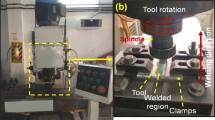Abstract
Ultrasonic-assisted laser welding on 321 stainless steel has been carried out to find out the effect of ultrasonic energy input on the microstructure and strength of the weld metal. Ultrasonic energy was transmitted from a transducer, via two waveguides and hard alloy indenter fixed perpendicularly on the workpiece surface. Real-time ultrasonic oscillation amplitude distributions over the workpiece surface and in the bulk of the workpiece have been obtained using the laser Doppler vibrometry and finite element simulation which allowed estimating the close to reality ultrasonic energy input values. The real energy input was at least two orders of magnitude less than that calculated from the nominal ultrasonic source power. The welded joints have been characterized for microstructure, microhardness, and tensile strength. It was shown using TEM that higher microhardness of the sonicated welded joint is due to high concentration of split dislocations induced by ultrasonics. The tensile strength of the ultrasonic-assisted-welded joint depended on the ultrasonic energy input and was higher than that of the base metal in case of sonication by 600 W output power.












Similar content being viewed by others
References
Campbell J (1981) Effects of vibration during solidification. Int Met Rev 2:71–108
Jose MJ, Kumar SS, Sharma A (2016) Vibration assisted welding processes and their influence on quality of welds. Sci Technol Weld Join 21(4):243–258
Tarasov SY, Rubtsov VE, Fortuna SV, Eliseev AA, Chumaevsky AV, Kalashnikova TA, Kolubaev EA (2017) Ultrasonic-assisted aging in friction stir welding on Al-Cu-Li-Mg aluminum alloy. Weld World 61:679–690
Kim JS, Watanabe T, Yoshida Y (1995) Ultrasonic vibration aided laser welding of Al alloys: improvement of laser welding-quality. J Laser Appl 7:38–46
Abramov OV (1998) High-intensity ultrasonics. Gordon and Breach Science Publishers, Amsterdam, p 515
Geiger M, Kägeler C, Schmidt M (2008) High-power laser welding of contaminated steel sheets. Proc Eng Res Devel 2:235–240
Cai C, Li L, Tao W, Chen X (2017) Effects of weaving laser on scanning laser-MAG hybrid welding characteristics of high-strength steel. Sci Technol Weld Join 22(2):1–6. https://doi.org/10.1080/13621718.2016.1199126
Woizeschke P et al (2017) Laser deep penetration welding of an aluminum alloy with simultaneously applied vibrations. Lasers Manuf Mater 4:1–12
Radel T (2017) Thermal impacts in vibration-assisted laser deep penetration welding of aluminum. Phys Procedia 89:131–138
Zhou S, Ma G, Wu D, Chai D, Lei M (2018) Ultrasonic vibration assisted laser welding of nickel-based alloy and Austenite stainless steel. J Manuf Process 31:759–767
Paterson MS (1952) X-ray diffraction by face-centered cubic crystals with deformation faults. J Appl Phys 23:805
Dupraz M, Beutier G, Rodney D, Mordehaid D, Verdier M (2015) Signature of dislocations and stacking faults of face centered cubic nanocrystals in coherent X-ray diffraction patterns: a numerical study. J Appl Crystallogr 48:621–644
Gorelik S, SkakovYu A, Rastorguev LN (1994) X-ray-graphical and electron-optical analysis. Moscow, MISIS, 328pp
Wagner C N J (1966) Local atomic arrangements studied by X-ray diffraction. In: Cohen J B, Hillard J E (Eds.), Addison-Wesley, Reading, MA
Masubuchi K (1980) Analysis of welded structures: residual stress, distortion, and their consequences. Pergamon Press Ltd, London
Inoue H, Koseki T, Ohkita S, Fuji M (2000) Formation mechanism of vermicular and lacy ferrite in austenitic stainless steel weld metals. Sci Technol Weld Join 5(6):385–396
Funding
This work was financially supported by the Russian Federation Ministry of Education and Science (agreement No. 14.607.21.0190, project identifier RFMEFI60717X0190).
Author information
Authors and Affiliations
Corresponding author
Additional information
Publisher’s note
Springer Nature remains neutral with regard to jurisdictional claims in published maps and institutional affiliations.
Recommended for publication by Commission IV - Power Beam Processes
Rights and permissions
About this article
Cite this article
Tarasov, S.Y., Vorontsov, A.V., Fortuna, S.V. et al. Ultrasonic-assisted laser welding on AISI 321 stainless steel. Weld World 63, 875–886 (2019). https://doi.org/10.1007/s40194-019-00716-1
Received:
Accepted:
Published:
Issue Date:
DOI: https://doi.org/10.1007/s40194-019-00716-1




